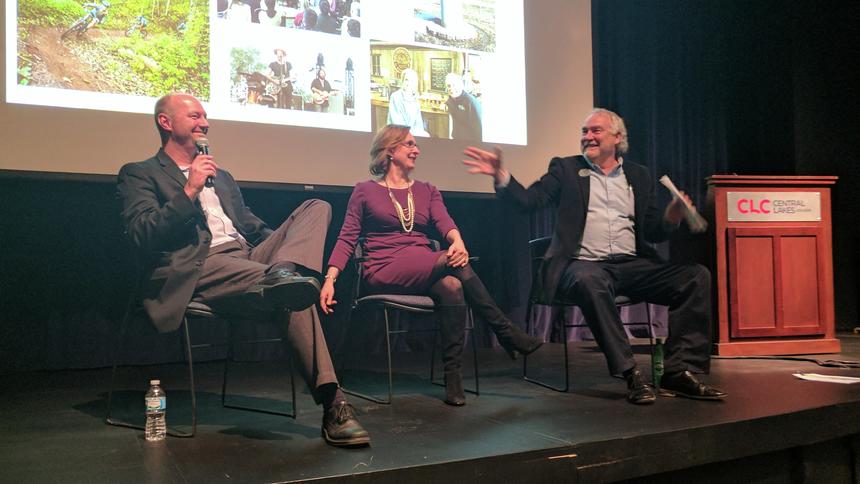A panel Thursday covered how to attract and retain workers—including those supposedly finicky millennials—to help combat a widespread workforce shortage.
“Help Wanted” was the latest Rosenmeier Forum hosted by Central Lakes College inside the Chalberg Theatre. The forums are organized by the Gordon Rosenmeier Center for State and Local government.
According to the Center for Rural Policy and Development, central Minnesota is expected to experience a 92 percent increase in the population age 64 or older by 2035, while the population of those ages 15-64 is expected to dip by 1 percent in the same timeframe.
Meanwhile, the Minnesota Department of Employment and Economic Development reported the highest number of job vacancies ever recorded in Region Five—2,325—during the second quarter of 2016. Region Five includes Cass, Crow Wing, Morrison, Todd and Wadena counties.
On Thursday, Mike Bjerkness, workforce director for the Brainerd Lakes Area Economic Development Corporation, Syvantis Technologies President Janelle Riley, and Karl Samp, executive director of the Brainerd Lakes Area Community Foundation, all gave their take on how to fight the trend.
Dan Hegstad, manager for Lakeland Public Television’s KAWB station in Brainerd, gave an introduction to the panelists in which he said he had observed firsthand the worker shortage in the Brainerd area. He mentioned a business manager he knew who laughed when asked if he did drug testing on his employees.
“He said, ‘If we had to drug test, I wouldn’t be able to hire anyone,” Hegstad recalled. “‘If you are not frothing at the mouth, we’ll hire you.’ That’s a direct quote.”
Samp started his presentation with a collage of photos he had taken of all the “Help Wanted” signs he had seen in Brainerd. He then delved into some of the causes of the workforce shortage.
Minnesota’s economy recovered faster from the recession than the national economy—3.8 percent unemployment at the state level compared to 4.5 percent nationally.
Then there’s the “rat going through the boa,” a statistical bump of aging baby boomers who are about to retire and leave the workforce. The age 25-64 slot in Minnesota is going to drop by 100,000 people beginning in 2017, and that demographic won’t return to full strength until 2040.
Midwestern states also lose people to “outmigration,” people moving to the coast and to the south, Samp said.
The only thing that’s going to drive growth in Minnesota will be immigrants to America, Samp said.
“One of the other challenges we face here is, we have a lack of immigrants filling entry level jobs,” he said of Brainerd.
Riley detailed the relaxed staffing approach at her company that allowed it to snag, and hold on to, millennial workers of all stripes. For starters, they take candidates with no experience and any kind of college major, even Ancient Greek. They then train the workers themselves.
“Why do I pick millennials? Well, first of all, they own the workplace now,” she said. “A lot of people my age don’t realize this yet, but they own it. Over 35 percent of the workforce right now is millennial generation, and in three years, it’s going to be over 50 percent.”
Millennials are also ideally suited to a tech company like Syvantis because they’re technology-apt, they embrace change, and they’re team oriented, she said.
Their Baxter office has weekly yoga sessions, soundproof rooms for collaboration, and a bar/keg in the office kitchen to help the workers socialize with each other and bond as a team.
However, it’s not just the tangible comforts millennials want, she said—it’s a sense of purpose and trust, where employers give their team the context to know how their work makes a difference, and give them the independence to achieve work goals on their own terms.
Bjerkness described the Brainerd Lakes Area Workforce Continuum, an initiative by BLAEDC to attract and retain workers. One facet that hasn’t received funding yet is called the Wise Employee Program, which would aim to teach middle school kids life skills, and how to be an effective employee when they get older. It’s a revamp of a program from 15-20 years ago where students would go after class to receive mentoring, and get a paycheck for completing their work.
Thursday’s forum occurred the same day as the Brainerd Lakes Chamber of Commerce and Enterprise Minnesota hosted a similar event that brainstormed ways to curb the worker shortage.


Recent Comments